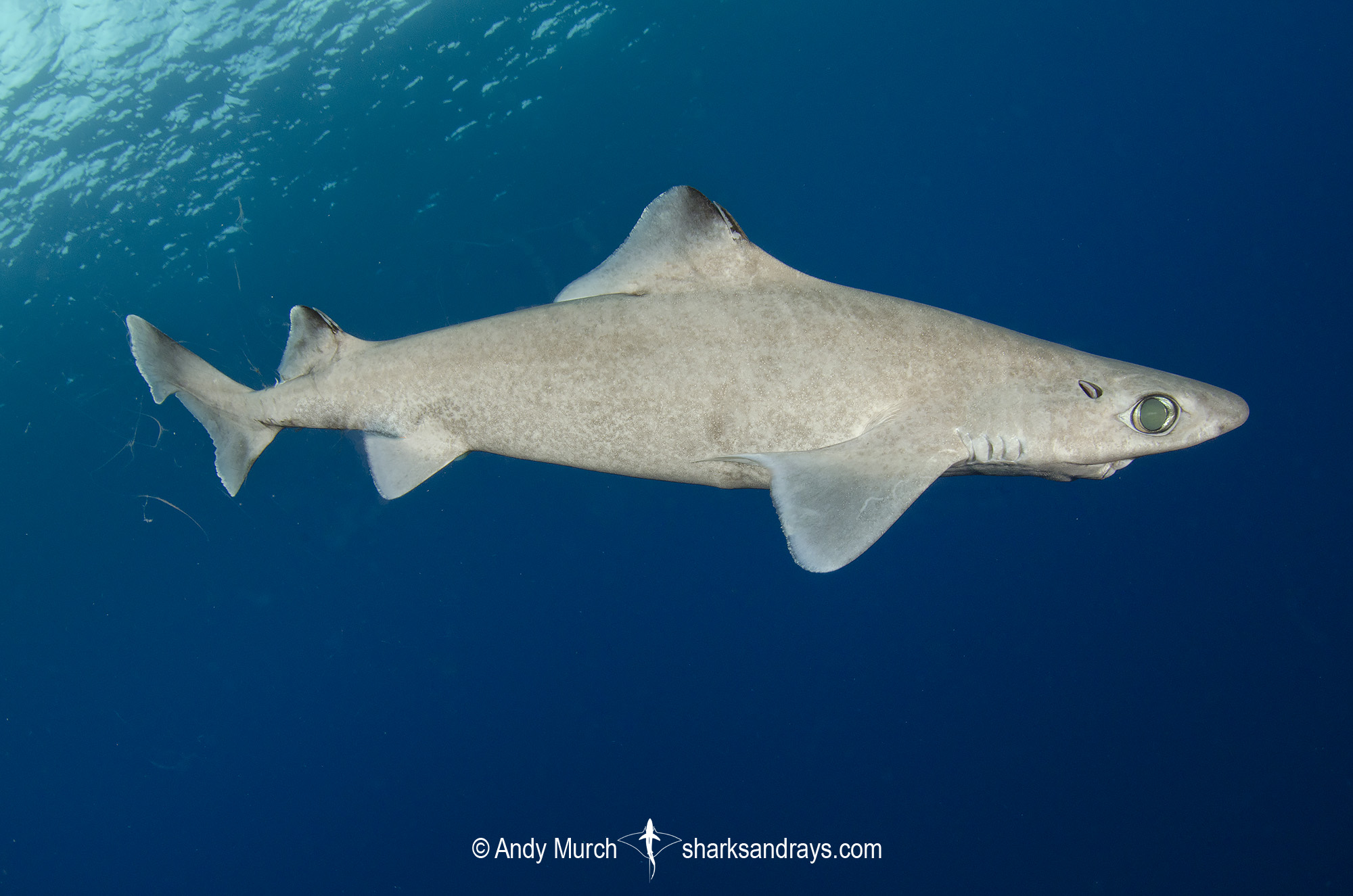Common names
Blackfin Gulper Shark.
Binomial
Centrophorus isodon.
Synonyms
Pseudocentrophorus isodon.
Identification
A small shark with a long, pointed snout, and large green-reflective eyes. Snout length almost 2x mouth width. Small, spiracle behind eye. Dorsal fins long and low, with anterior fin spines that are half the length of the dorsal anterior margin. First dorsal fin origin midway between pectoral fin insertion and free rear tip. Second dorsal origin slightly posterior to pelvic fin insertion. Pectoral fin free rear tip very long and thin.
Dorsal coloration grey to brownish grey. Ventrum slightly paler than dorsum. Dorsal fins dusky with black tips, darkest on the anterior half of the tip. Fin spines may also appear blackish. Thin, white or pale posterior margin on dorsal fins and caudal fin, and to a lesser degree on all fins.
Size
Maximum recorded length 108cm. Size at birth 31-35cm.
Conservation Status
ENDANGERED
The blackfin gulper shark is subject to fishing pressure across its range. It is targeted and taken as bycatch by deep-water gear, including demersal trawl, longline, and hook-and-line, and retained for the meat, fins, liver oil, and fish meal.
In Taiwan, by the 1950s, coastal fisheries were considered overfished, and fisheries expanded into offshore waters within the Exclusive Economic Zone (EEZ), and distant waters. The fisheries catch within the Taiwan EEZ continued to rise from the 1950s until 1980, after which it steadily declined (Kuo and Booth 2011). The number of powered vessels operating significantly increased from the 1950s (3,215 vessels) to the late 1980s (peaked in 1989 at 15,900), and then slowly decreased to 11,200 vessels in 2017 (Huang and Chuang 2010, Liao et al. 2019, H. Hsu Taiwan National Fisheries Statistics unpubl. data 2019). The artisanal fishing effort has steadily and markedly declined for non-powered sampans (8,283 to 239 from 1956 to 2004), but remains steady for fishing rafts (14,273 to 12,984 from 1956 to 2004) (H. Hsu, Taiwan National Fisheries Statistics unpubl. data 2019). In Taiwan, the demand for seafood has always been high and was 31.2 kg per capita in 2013 (Helgil 2019). Fish too small for human consumption are in demand for processing into fish meal feed for the aquaculture industry that produces double the quantity of seafood taken from wild capture fisheries in Taiwan waters (NDC 2016).
The Blackfin Gulper Shark is a bycatch of deep-water trawl fisheries that operate off the northeast and southwest coasts of Taiwan at depths of 300–700 m; these fisheries target multiple species of shrimp with all the incidental catch retained (D. Ebert unpubl. data 2019). The fishery on the east coast, particularly operations out of Da-xi, has moved into deeper waters over the past 30 years (from 1998–2019) due to depletion of shallow water shrimp species. The fishery has moved from fishing depths of 100–300 m to depths of 300–700 m (D. Ebert unpubl. data 2019). Prior to 30 years ago (about one generation length) this species would not have been fished in Taiwan as it was beyond the depth of the fishing gear. During the monsoon season, conditions preclude deep-water trawling and some trawlers operate in the shallower depths of 100–300 m (H. Ho pers. comm. 28 August 2019); this would provide a reprieve from fishing pressure for the Blackfin Gulper Shark. Deep-water longlines in Taiwan operate at depths of 100–300 m (H. Ho and H. Hsu pers. comm. 28 August 2019) and thus are unlikely to capture this species as its upper depth limit is beyond the reach of the longline gear.
In China, this species has only been reported to date from a research survey. Most commercial fisheries in China operate to a maximum depth of 300 m (X. Chen pers. comm. 28 August 2019) and thus are unlikely to capture this species.
In Indonesia, this species is taken on deep-water demersal longlines that operate at depths of 150–600 m (White et al. 2006). Fishing pressure in Indonesia is intense with the largest chondrichthyan fishery globally, and substantial catches of target and bycatch chondrichthyans (White et al. 2006). In the Philippines, deep-water dogfish are targeted for their liver oil using bottom set multiple hook-and-line gear and likely include captures of the Blackfin Gulper Shark (Flores 2004, Gaudiano and Alava 2003).
Citations and References
Rigby, C.L., Ebert, D.A. & Herman, K. 2020. Centrophorus isodon. The IUCN Red List of Threatened Species 2020: e.T44563A124432455. https://dx.doi.org/10.2305/IUCN.UK.2020-3.RLTS.T44563A124432455.en. Downloaded on 13 January 2021.
Habitat
A deepwater species of the continental slope. From 435-770m
Distribution
The blackfin gulper shark appears to be a wide ranging species but further research may lead to one or more regional splits. Eastern Atlantic – France to West and possibly South Africa (including the Mediterranean Sea). Western Atlantic – Gulf of Mexico to northern South America. Indian Ocean – Madagascar, Sudan and Western Australia. And Western Pacific south of Japan. Not recorded in the Eastern Pacific.
Reproduction
An aplacental viviparous species (without a yolk-sac placenta). Litter size unknown.
Diet
Blackfin gulper sharks feed on bony fishes and cephalopods.
Gulper sharks have highly distensible mouths that allow them to consume proportionately larger pray than other sharks of their size.
Behavior
Unknown. May form aggregations like other gulper species.
Reaction to divers
Not encountered by divers.
Diving logistics
Not encountered by divers.
What’s new
View our full list of updates
Similar species
Other Gulper Sharks There are at least 14 species of gulper sharks, many of which look very similar. The distribution of many species is poorly understood. Therefore, positive identification is best achieved by DNA Analysis and close examination of tooth and dermal denticle shape.






